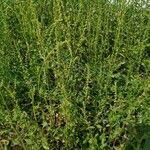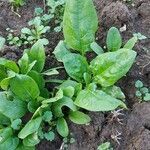An annual leafy vegetable. It grows 60-90 cm high and spreads 30-45 cm wide. The broad leaves are produced in a clump on short stalks. The leaves at the base are large and leaves on the stalk are smaller. Plants are separately male and female. (So both types are needed if seed is to be produced.) Flowers are greenish in spikes.
Stems leafy, 1-5(-10) dm. Leaves gradually becoming smaller distally; blade oblong, base cuneate. Bracteoles orbicular-obovate, usually wider than long, apex with divergent spine or smooth. 2n = 12.




